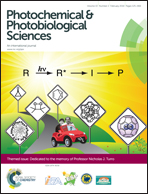Competing adiabatic and nonadiabatic pathways in the cis–trans photoisomerization of cis-1,2-di(1-methyl-2-naphthyl)ethene. A zwitterionic twisted intermediate†‡
Abstract
Identical fluorescence lifetimes and

- This article is part of the themed collection: Dedicated to the memory of Prof. Nicholas J. Turro

 Please wait while we load your content...
Please wait while we load your content...